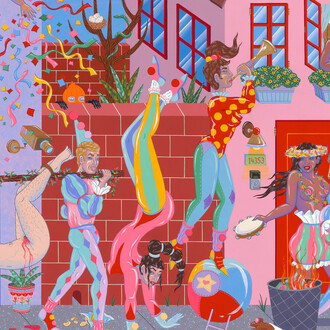Downtown Los Angeles’ Corey Helford Gallery (CHG) proudly unveiled a new series of works from Boston-based painter and designer Josie Morway, titled Course of Empire, in Gallery 2.
A self-taught artist, Morway’s extremely detailed style of oil and ink paintings on canvas combines the influence of Dutch Masters’ techniques, religious icon paintings, and hyper-modern color and design elements, to create paintings that have been described as “votive cave paintings from the distant future.”
The wildlife in Morway’s work is portrayed with an intense reverence that escalates to surreality, creating paintings that are both politically charged, ethereally poetic, and darkly comical. The artist’s incredible work explores both the fragility and the fortitude of the natural world, envisioning the sanctity of wildlife and wilderness in the face of human degradation and seeking to challenge the assumptions and projections we bring to our interactions with the wild.
Morway shares,
Thomas Cole created a series of paintings called The Course of Empire almost 200 years ago, ostensibly as a cry for the protection of nature against industrial encroachments. Over time and through changing political climates, perceptions of the artist and his work have swung wildly; at times he’s been considered a reactionary elitist – an early NIMBY of sorts, defending the interests of his conservative patrons – and at other times he’s been hailed as an effective advocate, not just for nature, but for the people, for workers and immigrants such as himself, against the predations of industrial barons and the commercial elite.
In echoing Cole’s title for her new series, the artist emphasizes the idea that the meaning of an artist’s work is not static, immediate, or within the artist’s control. Further, she asserts that the impact and import of a historical moment are often illegible to those living in that moment. “I always feel a strong pull towards commentary,” Morway says, “but I want to acknowledge the impossibility of accurately declaring where we are in the arc of our civilization. We’re inevitably hurtling forward without the benefit of our larger, eventual context, and I’m trying to make work that sits with that ambiguity, brings in potent elements and topics without being pedantic.”
Morway’s new work combines her characteristically intense, impeccable detail and realism with areas of mysterious texture and color to echo the jarring sensations of living at this moment in human history. She combines man-made and wild elements, vulnerable species, cultivated botany, urbanist scenes, and hyper-charged weather to reflect dueling elements of hope and trepidation, comfort and menace, and the disorientation of ever-accumulating history.
Morway adds,
The role of art is to offer a vision of the world as it could be, as well as to comment on the historical moment. But when the moment feels unnamable and analysis moot, its role is also to offer something ineffable but resonant, a sensory snapshot of how it feels to live in this time. The spin upon waking, the jungle inside, the source of that flash of light. The seeds in the bank, the cats in the streets. The bird in your heart and the wave at your door.
















